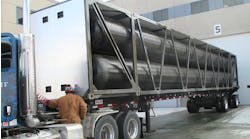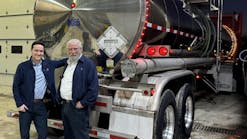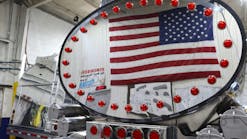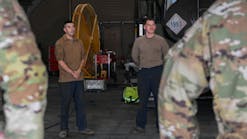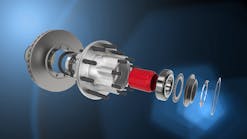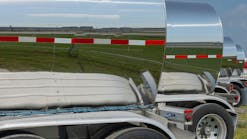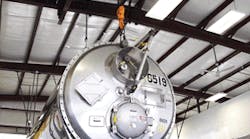SINCE late last year, Piston Tank Corporation has been assembling its tank trailers at a spacious new shop in South Roxanna, Illinois. It was a welcome change for the company that produces some of the most specialized tank trailers in the industry.
Encompassing 10,000 square feet, the new facility offers plenty of room for workers to assemble, maintain, and refurbish the patented piston trailers that are used to transport some of the most viscous products handled in bulk. The building was designed for energy efficiency and to provide a contaminant-free work area for assembly of some of the more sensitive components.
“This is a tremendous improvement over the assembly shop that had been used since the 1970s,” says Anthony DeJohn, vice-president of Piston Tank Corp, a subsidiary of Schilli Corporation. “We've got more room, and the building was designed for more efficient use of the space. We put a lot of time and thought into the design and layout of this building.
“In all, we spent about six months in planning. That included developing a detailed layout of the electrical wiring, plumbing, and air lines. We wanted to make sure our workers have easy access to everything they need perform their jobs safely and efficiently.”
Shop construction
Construction of the new facility startedin early 2010 and was completed in November of that year. Operating with five workers, the shop normally can turn out a piston trailer for industrial cargo in five to seven days. It takes longer to assemble a piston trailer for foodgrade cargo.
“Our new facility is the only location authorized for repair and refurbishment of piston trailers,” DeJohn says. “In most cases, we can turn a customer tank repair or refurbishment in five to seven days. We know how important it is to our customers to get their equipment back into service as quickly as possible.”
Most of the assembly, maintenance, and refurbishment work are done in the three bays that are the focal point of the metal building. The three primary work bays account for 5,500 square feet in the building. In the north half of bay number one is five-ton hoist on a 40-foot track that is used to handle tank heads and other heavy components.
Worker comfort
As part of the effort to make this a thermally efficient building, Piston Tank Corp executives specified six inches of insulation in the walls. Overhead doors at the work bays have an R-15 insulation factor. At least four inches of insulation is in the ceiling.
“Three gas space heaters are all we need to keep the work area warm in the winter, and we use very little natural gas,” DeJohn says. “In addition, we can keep the bays comfortable in the summer on most days just by opening the overhead doors. Four large 60-inch diameter ceiling fans supplement the natural air flow through the shop in both winter and summer.”
Walls include fire-resistant fiberglass-reinforced plastic panels bonded to plywood sheets to help keep the work areas looking clean and bright. Concrete floors are covered with a high-performance urethane coating that is easy to clean. Shop illumination is greatly enhanced by the use of T-5 high-output fluorescent lamps elevated 20 feet above the shop floor.
Electrical conduit, air lines, lubricant piping, and some plumbing are in the concrete slab. Six-inch diameter polyvinyl chloride (PVC) pass-throughs in the walls provide easy access for hoses and power cords.
“We can run three to four welding machines at once,” DeJohn says. “We have outlets positioned strategically so we don't have electrical cords lying all over the shop.”
A focal point of the new facility is the clean room — a 24-ft × 27-ft sealed area with a 16-ft ceiling — dedicated to contaminant-free, high-precision assembly of the pistons that give these tank trailers their specialized product handling capability. This area of the building is an environmentally controlled sanitary facility with a separate dedicated heating and cooling system, entrance air curtains, and a HEPA-filtered fresh-air-intake ventilation system. Technicians also use the clean room to assemble new electronic equipment for the cargo tanks.
On the west side of the shop is the compressor building containing the air compressor and bulk lubricants. “Putting those items in a separate building helps keep the shop cleaner and quieter,” DeJohn says. “We have a 30-foot separation between the two buildings, and we use that area to work on equipment outside when needed.”
With the new facility, shop technicians can work on three piston tanks at a time. The product has been steadily improved since being introduced in the mid-1970s. While the first piston tanks were assembled with fiberglass tubes, today's units are constructed of 316 stainless steel.
Piston tanks were developed to transport and store a wide range of viscous cargo. Products that have been handled in the tanks include grease, ink, caulking, automotive sound deadener, peanut paste, and chocolate.
“Industrial products account for the majority of the cargoes handled in our piston trailers,” DeJohn says. “However, food products comprise a larger percentage each year. There are many different types of viscous products that can be more efficiently handled in piston tankers. Our challenge is to identify them for our present and future customers. We have a small simulator that we use to test new product properties to help determine the feasibility of handling them using piston technology.”
Grease gun
In essence, today's piston tank can be considered a large grease gun on wheels. Compressed air is used for unloading most of the industrial products, but nitrogen is used for some foods. “This is a completely closed-loop loading and unloading system, which means virtually no chance of contamination,” DeJohn says.
The tanks use a combination of an air-driven piston and a pump (located on or off the trailer) to unload virtually all of the cargo. Unloading takes as little as an hour, and heels are minimal (generally no more than three to five gallons).
In comparison, unloading can take four to 48 hours when viscous products are handled in traditional tank and hopper trailers. Heels can range from 500 to 1,000 gallons. That can mean expensive cleanouts and lost product for the shipper and consignee.
The first piston trailers were developed to transport bulk grease and consisted of three fiberglass cylinders stacked in a triangle configuration and mounted on what is essentially a platform trailer frame. A few of these trailers are still in service.
Stainless steel
Now, however, the newest piston tanks in the fleet are constructed of stainless steel to DOT407 code and to Piston Tank Corp's proprietary specifications. The basic smooth-bore, insulated tank trailers are rated at 25 psi and have a full-opening, flanged front head.
“Maximum expel pressure is 18 psi, and most products only need six to 12 psi,” DeJohn says. “It's important to closely monitor the propellant air pressure because too much will reduce the seal efficiency. The distance to the pump, discharge line size, and the physical properties of the product determine the amount of pressure needed.”
Access to the tank is through a manway in the front and rear heads. Componentry at the front includes a means of tracking the position of the piston inside the tank. State-of-the-Art on-board tracking systems include laser devices and radar systems.
“It is critical to know where the piston is at all times,” DeJohn says. “Overfills that occur when the piston contacts the front head can cause structural piston damage.”
The trailers are set up for bottom loading, and the outlet is at the rear. Outlets of up to eight inches are specified, depending on the customer's application. Rear heads on the trailers are welded in place and are fitted with a large-capacity pressure-relief vent. Typical net tank capacity is 6,000 gallons, which enables a 45,000-pound payload for most of the cargoes handled in piston tanks.
Patented piston
The heart of the system is the patented piston assembly. The pneumatically driven piston has air-tight seals and a floating design. The seals are essentially inflatable O-rings.
Seals can be made of different materials to meet the requirements of the various cargoes and fit so snugly that liquids, as well as viscous commodities, can be transported in the trailers. Special guide assemblies keep the piston aligned in the tank so it won't twist or jam.
Along with the tank trailer, the cargo tank builder supplies the dished head that will be used as the piston. The dished-head piston is installed at the front of the tank, and faced to the rear.
“Our builders must supply us a perfectly round tank, and every foot of the barrel interior must be laser-mapped,” DeJohn says. “We want the piston head and tank heads dished at the same time when the tank is built. We must have a perfect fit for the piston to ensure that all of the cargo is expelled, leaving virtually no heel in the tank.”
International market
While most of the demand for the piston tanks has been in North America, an international market also exists. The piston system has been installed in swap tanks in Europe and Asia and in ISO tank containers that serve customers in Europe and Canada. Even in-plant storage tanks have been fitted with the piston system.
Piston Tank Corp's associate in Europe is VTS, a Belgium-based tank trailer outfitter. Piston Tank Corp builds the pistons at the South Roxanna facility and ships them to their Belgian associate.
“We guard our technology closely,” DeJohn says. “The corporation maintains numerous patents covering our piston technology in the United States, Canada, Mexico, Europe, and Asia.”
Piston tanks built in the United States and Europe are very similar for the most part. The biggest difference is tank diameter, which is larger in Europe versus the United States.
Piston Tank Corp continues to seek out new cargoes and new customers. “We plan to do more brand identification to raise the profile of our piston tank trailer,” DeJohn says.
Piston Tank Corp currently controls a fleet of approximately 70 piston tank trailers in North America. Another 22 piston tanks are serving customers in Europe and Asia.
Most of the tanks are leased to customers through Piston Tank Corp. In some cases, the company even arranges transportation for piston tanks in North America through other Schilli Corp subsidiaries. ♦

